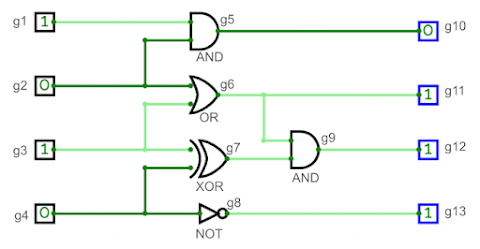題目敘述
每筆資料第一行有四個正整數P、Q、R、M,下一行會有P個整數 (0或1) 代表輸入端口的數值,接下來會有Q個正整數代表邏輯端的判斷類型 (1 為 AND、2 為 OR、3 為 XOR、4 為 NOT)。最後會有M行,每行有兩個正整數A和B,代表從A點到B點有一條線。點的命名方式可以餐考以下圖片,圖片為範例輸入/輸出 #1的解析圖。
要求輸出延遲的秒數 (會在解題思路中解釋) 和輸出端點的值。範例輸入 #1
4 5 4 13
1 0 1 0
1 2 3 4 1
1 5
2 5
2 6
3 6
3 7
4 7
4 8
5 10
6 9
6 11
7 9
8 13
9 12
範例輸出 #1
2
0 1 1 1
範例輸入 #2
5 6 4 15
1 1 0 1 0
2 1 3 4 1 3
1 6
2 7
7 13
7 6
3 7
3 8
4 8
5 9
8 10
9 10
10 14
10 11
9 11
6 12
11 15
範例輸出 #2
3
1 0 1 0
解題思路
可以使用一個struct來存取每一個端點/邏輯端的數值,將資料都收到struct中之後,使用BFS先跑輸入端點,將輸入端點的終點值的起點值存成目前的數字。經過判斷已經可以做邏輯端的運算後就可以將運算過後的值放到struct中存輸出值的變數。延遲的部分只需判斷跑了幾次的BFS再-1即可。
解題程式碼如下 (僅供參考):
#include <iostream>
#include <vector>
using namespace std;
struct node
{
vector<int>from;
vector<int>to;
int output = -1;
int delay = 0;
int gate = -1;
};
int delay = 0;
vector<node>vec;
void BFS(vector<int>start)
{
if (start.size() == 0) return;
delay++;
vector<int>newStart;
for (int i = 0; i<start.size(); i++)
{
node vv = vec[start[i]];
for (int j = 0; j<vv.to.size(); j++)
{
int to = vv.to[j];
vec[to].from.push_back(start[i]);
if ((vec[to].gate == 4 && vec[to].from.size() == 1) || (vec[to].from.size() == 2))
{
newStart.push_back(to);
node point = vec[to];
int gate = vec[to].gate;
if (gate == 1)
{
if (vec[point.from[0]].output == 1 && vec[point.from[1]].output == 1)
{
vec[to].output = 1;
}
else vec[to].output = 0;
}
else if (gate == 2)
{
if (vec[point.from[0]].output == 1 || vec[point.from[1]].output == 1)
{
vec[to].output = 1;
}
else vec[to].output = 0;
}
else if (gate == 3)
{
if (vec[point.from[0]].output != vec[point.from[1]].output) vec[to].output = 1;
else vec[to].output = 0;
}
else
{
if (vec[point.from[0]].output == 0) vec[to].output = 1;
else vec[to].output = 0;
}
}
}
}
BFS(newStart);
}
int main() {
cin.sync_with_stdio(0);
cin.tie(0);
int in, out, logic, line;
cin >> in >> logic >> out >> line;
vector<int>start;
for (int i = 0; i<in+out+logic; i++)
{
node tmp;
vec.push_back(tmp);
}
for (int i = 0; i<in; i++)
{
int tmp;
cin >> tmp;
vec[i].output = tmp;
start.push_back(i);
}
for (int i = in; i<in+logic; i++)
{
int tmp;
cin >> tmp;
vec[i].gate = tmp;
}
for (int i = 0; i<line; i++)
{
int a, b;
cin >> a >> b;
vec[a-1].to.push_back(b-1);
}
BFS(start);
cout << delay-1 << endl;
for (int i = in+logic; i<in+logic+out; i++)
{
cout << vec[vec[i].from[0]].output << " ";
}
cout << "\n";
}

留言
張貼留言